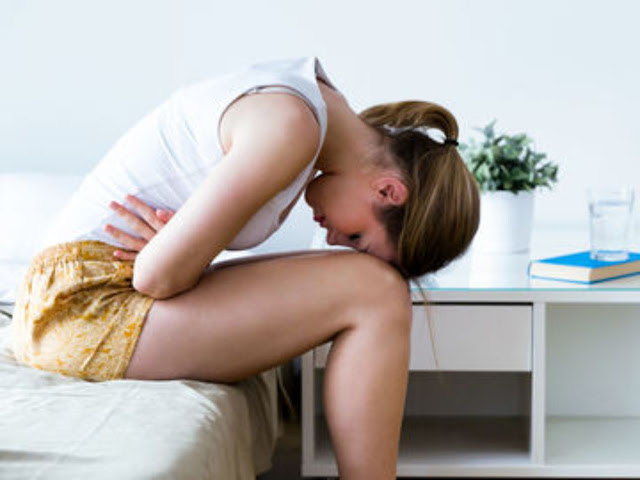According to the Austrian Endometriosis Association (EVA), between ten and 15 percent of women of childbearing age suffer from endometriosis. Although around three million women in Germany suffer from endometriosis, the disease receives little public attention.
According to the Endometriosis Association e.V., endometriosis is therefore only recognized and treated on average six years after it occurs. But what is endometriosis anyway, what are the symptoms of the disease and why is it often recognized so late?
 |
| Severe abdominal pain in young women is often not diagnosed as endometriosis. |
What is endometriosis?
In endometriosis, benign growths of cells similar to the lining of the uterus (endometriosis foci) occur outside the uterine cavity. These endometriosis foci behave like the mucous membrane inside the uterus (endometrium), so they build up and break down alternately during the woman's cycle and are also shed during the menstrual period.
Because endometriosis foci cannot be excreted through the vagina, they are sometimes broken down by the body via the surrounding tissue. However, the endometriosis foci often also trigger inflammation, adhesions, and adhesions, which can lead to severe pain.
In addition, endometriosis can trigger the formation of so-called chocolate cysts. These are fluid-filled cavities in which coagulated blood collects. The cysts appear brownish as a result.
In the video: These are the most common symptoms of the disease
More often than expected
Endometriosis is often recognized too late as the cause of abdominal pain in young women. In fact, endometriosis is the second most common gynecological disease. In Germany alone, around 40,000 women fall ill every year. Between puberty and menopause, depending on statistics and data, between 4 and 12 percent of women are affected by endometriosis.
What causes endometriosis?
To date, science has not been able to definitively determine why endometriosis often develops in young women. It is likely that genetic, immunological, hormonal, and mechanical factors can trigger the development of the disease.
Endometriosis symptoms
The symptoms of endometriosis can vary greatly from woman to woman. In exceptional cases, however, endometriosis can also be completely symptom-free. However, the occurrence and intensity of the symptoms are unrelated to the number and size of the growths and the stage of the disease. So there are women with large growths who can live without symptoms, but also women with small growths who suffer from severe pain.
These symptoms are most common in endometriosis
- abdominal pain
- Severe menstrual pain
- pain during sex
- mental stress
- Pain when urinating or having a bowel movement
- Problems with fertility up to infertility
Abdominal pain and menstrual cramps are perceived as “normal”.
The typical symptoms of endometriosis are one of the main reasons why the disease is often only recognized after many years of suffering. According to experts from the Endometriosis Research Foundation (SEF), many women, but also doctors, perceive abdominal pain, menstrual cramps, and other symptoms of endometriosis as “normal”.
When in doubt, gynecologists therefore often recommend painkillers to their patients instead of investigating the causes of the symptoms. So for many women with endometriosis, only the symptoms are numbed and the disease is not treated.
Endometriosis self-test via app
If the typical symptoms of endometriosis also apply to you, you can use the endometriosis self-test “Endo-AI” to get an initial assessment. According to Dr. medical Help Nadine Rohloff with self-reflection on your symptoms, but do not replace a medical diagnosis.
“Digital solutions can help! Therefore, with endometriosis. app and the endo app, we want to offer all women with endometriosis reliable information and individual support in all situations and especially in everyday life. Without waiting. Without a route," explains Dr. medical Nadine Rohloff from Endo Health GmbH.
Diagnosis of endometriosis at the doctor
After the endometriosis self-test thinks you have endometriosis, you should have your symptoms checked by a gynecologist or an endometriosis center. according to dr medical Nadine Rohloff, the self-test is not a diagnostic tool, but only an aid for an initial assessment. However, the results of the endometriosis self-test can help the treating physician with the diagnosis and should therefore be presented.
The subsequent diagnosis usually begins with a detailed conversation about the pain and symptom history of the patient. A gynecological examination is then carried out. If there is a suspicion of endometriosis, the diagnosis is made primarily by examining the tissue with an abdominal reflection (laparoscopy).
In some cases, however, doctors can also detect particularly pronounced endometriosis foci, cysts, and adhesions by means of ultrasound examinations of the vagina and abdominal wall. Unfortunately, endometriosis cannot be detected by simply examining blood values.
Endometriosis center instead of a gynecologist
Klaus Bühler, a board member of the Endometriosis Research Foundation (SEF), recommends going directly to an endometriosis center in the event of severe pain. Experienced gynecologists can in principle also diagnose the disease, but are often under great time and financial pressure.
As a result, they often do not take the time required to talk to the patient and carry out the subsequent diagnostic tests. It is therefore not uncommon for endometriosis to go undetected by a gynecologist.


Post a Comment